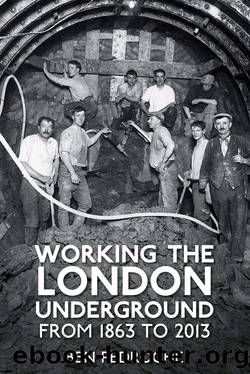Working the London Underground: From 1863 to 2013 by Ben Pedroche

Author:Ben Pedroche [Pedroche, Ben]
Language: eng
Format: epub
Publisher: The History Press
Published: 2013-09-12T22:00:00+00:00
Arnos Park Viaduct, built when the Piccadilly line was extended to Cockfosters. (Author)
With the continued expansion of the underground railways out towards the suburbs, major roads began to create a new obstacle that would need to be manoeuvred. The Piccadilly line was extended from Finsbury Park to Cockfosters in the 1930s, on a route that required the railway to cross the North Circular near to what on the opening of the line would become Arnos Grove station.
To build a bridge over a functioning road was uncharted territory for the engineers and builders working on the line, and an additional road crossing was required further north, adjacent to Arnos Grove. This time the railway was built to run beneath the road, with Bowes Road reconstructed on a section of bridge above.
Further north of Arnos Grove, between here and Southgate station, the extension onwards to Cockfosters also necessitated the construction of a viaduct that took the new railway across Arnos Park. It is an impressive structure with thirty-four individual arches, and is said to be the last brick viaduct to be built anywhere in the UK.
The Piccadilly line was extended several more times during the twentieth century, this time to the west of London. By 1933 the railway had reached Uxbridge, taking over services previously operated as part of the Metropolitan District Railway. A new branch line was also constructed in the 1930s from Acton Town to Hounslow West, again running on lines built originally by the Metropolitan District Railway.
Hounslow West remained as a terminus station until the mid-1970s, when construction began on an extension via a new set of tunnels to Hatton Cross. It was part of a project to connect the London Underground network to Heathrow, and by 1984 the line had reached the airport, with new stations serving each of its four terminals.
Construction work continued well into the twenty-first century, with a new station opened in 2008 to serve Terminal 5. The terminal was reached by new tunnels that were built using huge Tunnel Boring Machines (TBMs) â a far cry from the Greathead Shields used to construct the first section of the line over a century earlier (see later section for more on how TBMs are used today).
The change of name from the GNP&BR to the Piccadilly line was the result of the UERL being absorbed into the unified London Underground network. It was also during this period that a number of original GNP&BR stations were closed. The original section from Finsbury Park to Hammersmith had been somewhat overzealous with the number of stops it was estimated would be needed to best serve demand. By 1934 the stations at Down Street, Brompton Road and York Road had all closed due to low passenger use. The station at Dover Street meanwhile was replaced by Green Park.
UPS AND DOWNS
The first London Underground escalator was installed at Earlâs Court in 1911. Its success led to many other stations across the system having them installed, often as a replacement for lifts. Adapting
Download
This site does not store any files on its server. We only index and link to content provided by other sites. Please contact the content providers to delete copyright contents if any and email us, we'll remove relevant links or contents immediately.
What's Done in Darkness by Kayla Perrin(25501)
Shot Through the Heart: DI Grace Fisher 2 by Isabelle Grey(18220)
Shot Through the Heart by Mercy Celeste(18160)
The Fifty Shades Trilogy & Grey by E L James(17777)
The 3rd Cycle of the Betrayed Series Collection: Extremely Controversial Historical Thrillers (Betrayed Series Boxed set) by McCray Carolyn(13190)
The Subtle Art of Not Giving a F*ck by Mark Manson(12916)
Scorched Earth by Nick Kyme(11834)
Stepbrother Stories 2 - 21 Taboo Story Collection (Brother Sister Stepbrother Stepsister Taboo Pseudo Incest Family Virgin Creampie Pregnant Forced Pregnancy Breeding) by Roxi Harding(11040)
Drei Generationen auf dem Jakobsweg by Stein Pia(10217)
Suna by Ziefle Pia(10186)
Scythe by Neal Shusterman(9265)
International Relations from the Global South; Worlds of Difference; First Edition by Arlene B. Tickner & Karen Smith(8614)
Successful Proposal Strategies for Small Businesses: Using Knowledge Management ot Win Govenment, Private Sector, and International Contracts 3rd Edition by Robert Frey(8419)
This is Going to Hurt by Adam Kay(7698)
Dirty Filthy Fix: A Fixed Trilogy Novella by Laurelin Paige(6454)
He Loves Me...KNOT by RC Boldt(5805)
How to Make Love to a Negro Without Getting Tired by Dany LaFerrière(5378)
Interdimensional Brothel by F4U(5305)
Thankful For Her by Alexa Riley(5164)
